« April 2010 |
Main
| June 2010 »
 May 27, 2010 | Guitar to Mandolin
May 27, 2010 | Guitar to Mandolin
Many mandolinists have taken that path of branching out from months or years of playing guitar to our small 8-string wonder. Whether they are driven from (in the case of a frustrated guitarist) or drawn to, the mandolin offers a whole new world of sonority, expression, and challenges. We want to explore some important concepts for those pondering that move.
First thing to remember: It's not a little guitar.
Despite the similarities, strings, frets, pick, wood, etc, the mandolin is really an instrument of its own. The size and tuning are the most obvious difference, but there is a common misconception in how small hands have to be to play the mandolin. While a guitar player is used to chromatic one finger-one fret in most playing, the mandolinist (like the violinist) skips a 1/2 step and for the most part things of the instrument diatonically. In other words, one note per note of the scale, occasionally 1/2 steps but mostly two frets at a time per finger. Fingers spread from 1st to 4th fret will stretch 5-1/8", at the most on a guitar. On a mandolin that same index to pinky stretch at the most is 4-5/8", 1st fret to 7th.
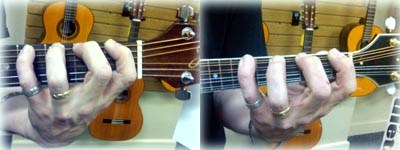
It should make you chuckle when a guitar player bemoans, "I could never play the mandolin; my fingers are too big."
It's critical to understand the three things a mandolin does well in departing from the "little guitar" approach: tremolo, soprano melody, and cross picking. Yes, you can do the clacky, clacky accompaniment chord thing, but we'll explain in a moment the dangers in making this your only skill.
Tremolo. The double course and lighter gauge mandolin strings make a tremolo work far better than you could dream. Even Django Rheinhardt was teased about making his instrument sound mandolin-like. It's associated with it in Europe literally for centuries. This is an effect to exploit, so take the time to master it.
Soprano Melody. When the rest of the band plays lightly and the mandolin is exposed playing the melody, the angels sing. That lighter timbre is a welcome contrast from the heavier instruments. You need to master a smooth sense line, notes bleeding from one to the next. Connect, connect, connect, all the time. Shorter strings decay quicker so you need a good articulation with the pick and an even more secure left hand grip in between the frets.
Cross picking. You won't have the multiple finger pick attack of the banjo, but that piercing flow of notes isn't always what the audience wants to hear. The mandolin allows a subtle subdivision that lends the ensemble energy without being overbearing. Good cross-picking technique is well worth the investment of time.
What not to wear.
We mentioned the "clacky, clacky" chording thing. It's not horrible when the mandolin is solo, although without the lower tenor register, the mandolin makes for a tepid accompaniment instrument. It's okay for variety sake, but after several songs, the ear wants to hear some bass. Worse, when you have mandolin and guitar playing clacky chords together, they have to be impeccably in sync or it sounds awful. Bad news too--the mandolin gets blamed no matter who is off. The audience hears rhythmic irregularity, and ultimately, the higher instrument gets the blame. You are far better off lending the band the simplified back beat "chop" of a steady, metronomic pulse.
It's great if you can do mandolin and guitar. Not everyone can handle the multi-instrumentalist switching back and forth thing, and it's not uncommon to see a mandolinist completely give up the guitar. One direction you can go to avoid confusion is to pick up a tenor guitar which is tuned CGDA like a mandola, or sometimes like an octave mandolin GDAE. Same with a tenor banjo, but we'll leave that for another time.
Further:
Line, Please? The importance of sustain.
Complements of you...
Punctuation and percussion; what you can learn from a good drummer.
Plays Well With Others...
Posted by Ted at 6:46 AM
 May 20, 2010 | Middle ground; reading jazz fake books
May 20, 2010 | Middle ground; reading jazz fake books
Many who start playing guitar or piano jump into popular music by reading PVG (piano/vocal/guitar) song sheets. Handy, the songs have some kind of simplified arrangements summarizing the important parts of the original recording, mostly the melody at the top, lyrics under the staff, and a listing of chords with fretboard diagrams above. It's easy to understand the marketability, a pianist has something "whole," the vocalist has the lyrics, a guitar player has basic chords spoon fed above the staff.
Jazz, on the other hand, involves a title, sketch melody line, and chords written above. For someone coming from the Pop/Guitar world, this can be intimidating. For a mandolinist, even more so, no suggested fingerings for the chords, and the question comes, "Where do I begin?"
A working internal library of basic chords will help, but keep in mind, these tunes are played over and over again, the "head" and multiple repeats ad nauseum. To take the "nausea" out of the equation, a good mandolinist will know many variations of the chords and splice them into different combinations. Printing one set of "suggested" chords above a lead line is a bit like putting training wheels on a bicycle. If you want to pedal fast, you have to kind of just get on and ride. You will always want to mentally frame that new chord you just learned as one of many variations.

Where does one start exploring this vast frontier of chord possibilities? Best to get a few chord variations under your belt before tackling the tune itself. The repetition of the chords in your fingers over time helps you learn the chords even better, especially if you can frame them mentality so as to think transpositions. For example an EMaj7 shape down a fret is an EbMaj7, down again is DMaj7, the same going up, is FMaj7, F#Maj7. Next time you need a Maj7 chord, you can draw on your knowledge of similar chords and transpose. Learn one Maj7, you've learned as few as three, as many as nine depending on how high you want to go up the fretboard.
Once you learn a couple variations of the EMaj7 shape (3- and 4-note chords) this isn't as intimidating as it seems, and you can read the chord symbols of a fakebook without even having to think. It gets even better when you uncover chord combination commonalities from song to song.
What we are talking about is essentially music theory, but let's also recommend you need the repetition in your fingers (and ears) before these concepts take hold in your brain. You start your working chord vocabulary slowly, and add over time, but that's what keeps the genre so fresh and exciting. You are perpetually learning new fun ways to play down an accompaniment.
So you want to get a jump start? We recommend some of the fine swing materials produced by Dix Bruce and Pete Martin. Dix has a great two-book collection of "working" Gypsy Jazz Standards, and a full band accompaniment to practice with. The tunes are already established standards, many will probably already be familiar to your ears. Pete has an online book you can try in PDF format, a little more about theory, and if you like it, pay him afterward, kind of a "shareware" approach. We suggest you get both.
Of course, you can also dive into our book, too: Getting Into Jazz Mandolin. Though it isn't full literature per se, there are some physical and intellectual nuggets that can help you get down that road to tackling a fakebook, and of course our online Webtracks Audio Support.
Further:
Introduce me to Gypsy Jazz
Mark Wilson's Grips
More m7b5 (from the Pros!)
ii V7 I Home Positions
Mike Marshal Mandolin Methods
Posted by Ted at 1:42 PM
 May 13, 2010 | Top Five 'Hover' Tones
May 13, 2010 | Top Five 'Hover' Tones
We revisited the notion of "gravity" in melody a couple weeks ago. We mentioned in particular, the pull of the 4th and 7th scale degrees, but we thought we'd expand these and call out our Top Five "Hover" tones.
Think of the drama of a Life-flight helicopter attempting to make a landing at a hospital, right before they are able to clear the emergency pad. There is tension literally in the air, as pilot, staff, observing public, and no doubt the patient as they wait to land. Maybe the drama of a scale degree is nothing compared to this, but you get the idea. Some notes "hover" as they wait to fulfill their mission, to land on the note that brings a sense of completion. We give you our personal Top Five:
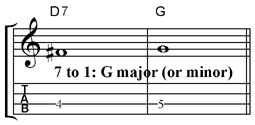 7 to 1 Major & Minor Scale. 7 to 1 Major & Minor Scale.
This is really a no-brainer, and the single most recognizable melodic pull in the tonal universe. Run the first seven notes in a G major scale and stop on the F#, just short of completion. Gaze around and see how many in the room look at you in anticipation. Many might even participate and sing the note G out for you, just to stop the demons from coming. Notice this is the same in both major and minor scales. That half-step relationship offers a very strong vertical bond.
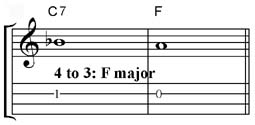 4 to 3 Major Scale. 4 to 3 Major Scale.
While not quite as strong as the previous 7 to 1, this is a potent one, too. Partnered up with the 7 to 1, you get the Tritone harmonic pull, the 4th & 7th to the 3rd and 1st. Even by itself, in the major scale its half-step tug demands its destiny, that "welcome home" 3rd scale degree.
 6 to 5 Minor Scale (AKA b9). 6 to 5 Minor Scale (AKA b9).
We have to give equal time to the minor scale and mention the 6th degree, where again we have a half-step pull to the 5th. We've mentioned its role as the b9 of the V7 chord (V7b9) above, but we could also point to the dominant preparation chord, the ii7b5 or Bm7b5, "F" in the above example. Eventually, it longs for the 5th note of the minor scale.
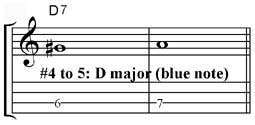 #4 to 5 Blues Scale. #4 to 5 Blues Scale.
This may be cheating a little, because it's not really a major or minor scale tone, unless you're talking a Blues Scale. We mention it because it's a very popular coloring tone, and one of those "blue" notes oozing with character. You can think of it as a b5 scale degree, too. What you call it is your choice, depending on what direction you're going, toward the 5, or teasing with a little half-step dip away from the 5 and back.
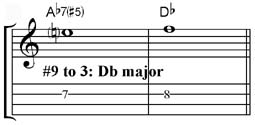 #9 to 3 Major Scale #9 to 3 Major Scale
This might be more esoteric, because we usually think of the #9 (or raised 2) in the context of a chord. It can still pack a punch melodically, and when used in an augmented chord, it needs to its face its fate. Best not to just leave it hanging there.
Why bother?
Voicing is everything in music. Even when you're stringing a succession of chords, these notes should eventually find their nearby mate. Since they are only a fret away, you should maximize your chord effectiveness by hooking chords together that consciously (and conscientiously) match these individual note pairs up. More importantly, if you are soloing, you want to exploit the momentary melodic tension and release here that makes the difference between runny notes, and running notes.
Make 'em count!
Further:
Moving Forward; Melodic Progression
4 and 7. The Committal Notes
Intentional Improvisation
More Appropriate
Some Minor Issues: 'Gravity' Notes in Minor
Posted by Ted at 2:09 PM
 May 6, 2010 | Two-chord jam; feed the beast.
May 6, 2010 | Two-chord jam; feed the beast.
Last week in our article "Moving Forward; Melodic Progression," we mentioned the different perceptions of the "direction" in music, horizontal and vertical. Recall, music can be melody, it can be chords, and usually a combination of both. We took a close look at the notion of "pull" in the former, but this time we want to look at communicating the harmonic, vertical "guts" of a simple two chord jam.
You could think of these as the first two chords of a 12-bar blues. You could also just take them as they are; maybe you actually sat in a rehearsal waiting for other band members to get their gear plugged in, and someone started wailing on these. It could even be said that major professional careers have been launched on not much more than these two chords.
A7, D7
If we analyze these, we could label them I7 and IV7. In the key of A, they would be based on the first and fourth scale degrees. Notice with the lowered 7th, we have the problematic departure from a major scale (A, B, C#, D, E, F#, G#, A) from G# to G natural, but this is the character of the whole blues genre, that restlessness or defiance, the unsettled esoteric theme of "I'm never happy" communicated in the lyrics, as well. We have the same in the D7 (D, E, F#, G, A, B, C# D), we lower the 7th from C# to C natural.
Two scales you'd use to jam on (don't say "Blues Scale," you advanced theory people; we aren't there yet...) would be:
A7 : A, B, C#, D, E, F#, G, A
D7: D, E, F#, G, A, B, C, D
You'd be fine wandering around these notes (theory buffs call these Mixolydian), but the real harmonic "meat" here is in the 3rd and 7th of each chord, that restless Tritone of C#/G and F#/C. Notice if we invert the second one on the fretboard (C/F#), we have a nice one-fret movement, down:
 
This is what you want to emphasize when jamming on the chords. No matter what kind of melodic detours you take, you want to feed the beast. When you're playing an A7 and D7 chord, the attention needs to go to them.
What's cool about the mandolin fretboard is how these notes are duplicated with a visually clear geometric pattern. Take these notes all around and you can access this secret treasure intuitively and intentionally.
 
Okay, you blues experts, add in your harmonic library the lowered 5ths (A7 would be Eb, D7 would be Ab) and minor 3rds (A7 would be C natural, D7 would be F natural) if you want, but the main thing here is grab these tritone notes. You'll really impress your friends!
Whatever you do, don't tell them how easy it is to do this on a mandolin...
Further:
Mandolin Chord Economics
Jazzed Pentatonics
Applying Turnarounds
Another look at Turnarounds
Chord Combinations for the Lizard Ear
Posted by Ted at 9:41 AM

Disclaimer: In the 'Information Age' of the 21st Century,
any fool with a computer, a modem, and an idea can
become a self-professed 'expert." This site does not
come equipped with 'discernment.'
|



